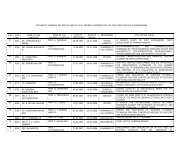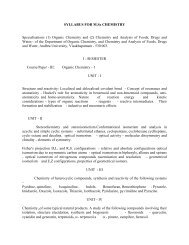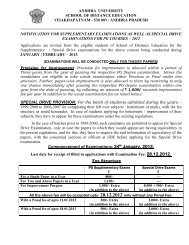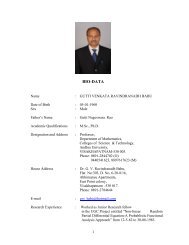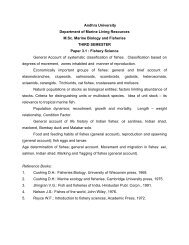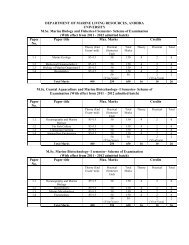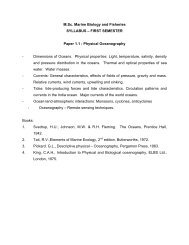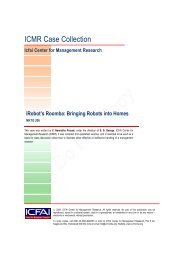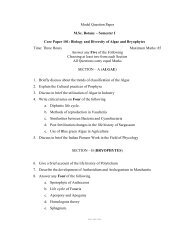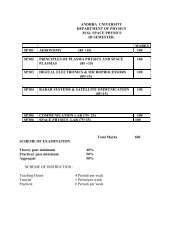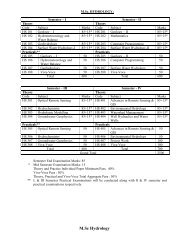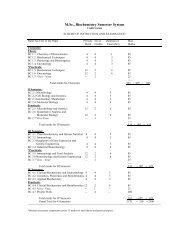annexure - a andhra university: college of engineering department
annexure - a andhra university: college of engineering department
annexure - a andhra university: college of engineering department
You also want an ePaper? Increase the reach of your titles
YUMPU automatically turns print PDFs into web optimized ePapers that Google loves.
MEC 212(A): ENGINEERING MECHANICS –I<br />
(Common for Mech., M.P.I., Metallurgy, Mech.Marine and Naval Architecture)<br />
Periods/week: 5 L Credits: 4 Sessionals: 30 Exam: 70<br />
Concurrent forces in a plane and its equilibrium. Centroids <strong>of</strong> composite plane figures. General case <strong>of</strong><br />
forces in a plane. Moment <strong>of</strong> inertia <strong>of</strong> plane figures. Parallel axis theorem. Polar MI. Concept <strong>of</strong> mass MI.<br />
Rectilinear translation. Kinematics. Principle <strong>of</strong> dynamics. Motion <strong>of</strong> a particle under constant force. Force<br />
proportional to displacement and free vibrations (SHM) . D’Albert’s principle. Momentum. Impulse work and<br />
energy. Rotation <strong>of</strong> a rigid body about a fixed axis kinematics. Equation <strong>of</strong> motion <strong>of</strong> a rigid body about a fixed<br />
axis. Rotation under constant moment. Torsional vibration.<br />
Text books:<br />
1. Engineering Mechanics – S.Timoshenko (relevant sections only)<br />
2. Elements <strong>of</strong> Strength <strong>of</strong> Materials- S.Thimoshanko (relevant sections only)<br />
MEC 213 (A) STRENGTH OF MATERIALS<br />
(Common for Mech., M.P.I., Metallurgy, Mech. Marine and Naval Architecture)<br />
Periods/week: 5 L Credits: 4 Sessionals: 30 Exam: 70<br />
Simple stresses and strains. Stresses on inclined plane. 2-Dimensional stress systems. Principal stress<br />
and principal planes. Mohr’s circle. Shearing force and bending moment. Types <strong>of</strong> loads. Types <strong>of</strong> supports. SF<br />
and BM diagrams for formula. Bending stresses in the above types <strong>of</strong> beams with rectangular and circular<br />
sections. Torsion <strong>of</strong> circular shafts. Determination <strong>of</strong> shear stress.<br />
Text books:<br />
1. Engineering Mechanics – S.Timoshenko (relevant sections only)<br />
2. Elements <strong>of</strong> Strength <strong>of</strong> Materials- S.Thimoshanko (relevant sections only)<br />
MTE 214 FUELS, REFRACTORIES AND FURNACE TECHNOLOGY<br />
Periods/week: 3L-2T Credits: 4 Sessionals: 30 Exam: 70<br />
Solid fuels. Classification. Theories <strong>of</strong> formation <strong>of</strong> coal. Study types and properties <strong>of</strong> coal.<br />
Proximate analysis & ultimate analysis <strong>of</strong> coal. Carbonization <strong>of</strong> coal. Coke and by products. Testing and<br />
properties. Liquid fuels. Classification. Theories <strong>of</strong> formation <strong>of</strong> petroleum. Petroleum refining. Distillation.<br />
Synthetic petrol. Bergius process. Fischer-Trospesch process. Coal tar fuels. Testing and properties. Gaseous<br />
fuels. Classification. Production <strong>of</strong> PG,WG, CWG,LD gas, Coke oven gas and BF gas. Industrial gasification<br />
processes. Lurgi, Winklers and Kopper_ Totzek processes. Properties and testing. Liquid and gaseous fuel<br />
burners. Combustion problems.<br />
Refractories. Definition . Properties, classification and general description. Manufacturing <strong>of</strong><br />
refractories. Manufacture, properties and applications <strong>of</strong> Alumino-silicate, Silica, Dolomite, Magnesite,<br />
Chromite and Carbon refractories. Importance and study <strong>of</strong> SiC,ZrO2 and cermets. Testing <strong>of</strong> refractories.<br />
Furnaces. Classification <strong>of</strong> furnaces and their use in metallurgical industries. Elements <strong>of</strong> heat<br />
transmission. Steady state conduction, convection and radiation. Heat utilization in furnaces, available heat,<br />
factors affecting it. Heat losses in furnaces and furnace efficiency. Heat balance and Sankey diagrams.<br />
Principles <strong>of</strong> waste heat recovery. Recuperators and regenerators. Types and applicability. AMTD and LMTD in<br />
recuperators. Protective atmosphere and their applications . Salt bath furnaces.<br />
Text books:<br />
1. Fuels, furnaces and refractories by O.P.Gupta<br />
References:<br />
1. Fuels, Technology by Hinues<br />
2. Fuels by Gilechrist<br />
3. Refractories by Chesty<br />
4



